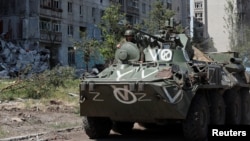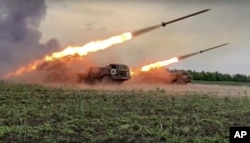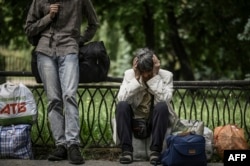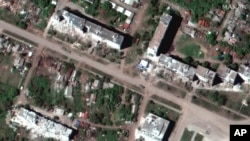Ukrainian President Volodymyr Zelenskyy says Russian forces are occupying about 20% of Ukrainian territory as the war approaches its 100th day on Friday and fighting continues on several fronts.
“Just imagine! Constant fighting, which stretched along the front line for more than a thousand kilometers,” Zelenskyy told the Luxembourg parliament in a virtual speech Thursday. He said the Ukrainian area controlled by Moscow’s forces is comparable to the entirety of the Netherlands.
Zelenskyy did not say how much territory Russia has captured since the start of its invasion February 24. Moscow seized Ukraine’s Crimean Peninsula in 2014 and Russia-backed separatists had also captured parts of the eastern Donbas region, where fighting is the most intense now, prior to the invasion.
Ukraine said Thursday its forces have recaptured 20 small towns and villages in the Kherson region in the southern part of the country. Meanwhile, Russian forces continued their assault on Sievierodonetsk, the last major city nominally held by Ukraine in the Luhansk region in the eastern part of the country.
Luhansk Governor Serhiy Haidai said Russia controlled about 70% of the city as fierce street battles took place.
Britain's defense ministry said Russia has taken control of most of the city. The ministry said Ukrainian forces control the main road into Sievierodonetsk, with Russia making "steady local gains, enabled by a heavy concentration of artillery."
A Ukrainian official said Kyiv’s forces were hoping to recapture territory lost earlier in the war in southern Ukraine in part to tie up some Russian forces more focused on fighting in the Donbas region.
“This new package will arm them with new capabilities and advanced weaponry, including HIMARS with battlefield munitions, to defend their territory from Russian advances,” Biden said in a Wednesday statement. “We will continue to lead the world in providing historic assistance to support Ukraine’s fight for freedom.” Biden used the acronym for the High Mobility Artillery Rocket System.
Administration officials said this new weapons package is “tailored to the needs” of the current phase of conflict, which is unfolding in Ukraine’s east.
Undersecretary of Defense for Policy Colin Kahl said Wednesday the United States is sending four of the new rocket systems, and that it will take about three weeks to train Ukrainian forces to use them. He declined to say where that training would take place but said the systems are on the European continent.
“What the HIMARS will allow them to do is to get greater standoff” range against targets more than 70 kilometers away, he said. “So right now, the howitzers we provided them have about a 30-kilometer range, the HIMARS have more than twice that, which will allow them, even with fewer systems, greater standoff. And the other thing that distinguishes this is an extraordinary amount of precision.”
Speaking in Washington alongside Secretary of State Antony Blinken on Wednesday, NATO Secretary-General Jens Stoltenberg said it’s not clear how or when this conflict will end, but that NATO wants to see Ukraine in a position of strength when peace talks happen. Blinken said Russia holds the power to slow or stop the conflict.
Biden wrote in an opinion piece in The New York Times, released late Tuesday that he does not seek war with Russia.
“As much as I disagree with Mr. Putin, and find his actions an outrage, the United States will not try to bring about his ouster in Moscow,” Biden said. “So long as the United States or our allies are not attacked, we will not be directly engaged in this conflict, either by sending American troops to fight in Ukraine or by attacking Russian forces. We are not encouraging or enabling Ukraine to strike beyond its borders.”
Russian Foreign Minister Sergey Lavrov warned that the supply of rocket launchers to Ukraine raises the risk of expanding the conflict, and called Ukraine’s push for weapons from its Western allies a “direct provocation intended to draw the West into the fighting.”
Kremlin spokesman Dmitry Peskov told reporters Wednesday that the U.S. weapons shipments do not encourage the renewal of peace talks.
The decision to send more advanced weapons follows earlier reluctance on the part of the Biden administration. White House officials told reporters late Tuesday that the new weapons package — the 11th such tranche of weapons the U.S. has sent to Ukraine — includes the rocket system, counter-fire radars, air surveillance radars, additional Javelin anti-tank missiles and other anti-armor weapons.
The U.S. is also sending more helicopters, more than 200,000 artillery rounds and a package of spare parts to help the Ukrainians fix their existing equipment.
Russian forces continued their push to capture the city of Sievierodonetsk, key to its efforts to seize the Donbas region in eastern Ukraine. Luhansk Governor Serhiy Haidai said Russia controlled about 70% of the city as fierce street battles took place.
Britain's Defense Ministry said Russia has taken control of most of the city. The ministry said Ukrainian forces control the main road into Sievierodonetsk, with Russia making "steady local gains, enabled by a heavy concentration of artillery."
Anita Powell contributed to this report. Some information also came from The Associated Press, Agence France-Presse and Reuters.















